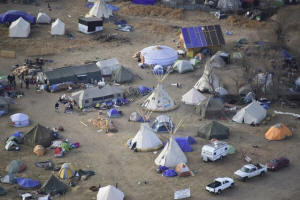|
Police fire water cannon at Dakota
pipeline protesters in freezing weather
 Send a link to a friend
Send a link to a friend
 [November 22, 2016]
By Chris Michaud and Stephanie Keith [November 22, 2016]
By Chris Michaud and Stephanie Keith
NEW YORK/CANNON BALL, N.D. (Reuters) -
Police fired tear gas and water at hundreds of protesters in the
freezing North Dakota weather late Sunday and early Monday, in the
latest violent clash over a pipeline project running through the state.
An estimated 400 protesters mounted the Backwater Bridge just north of
Cannon Ball, North Dakota, and attempted to force their way past police
in what the Morton County Sheriff's Department described as an "ongoing
riot."
The $3.7 billion Dakota Access project has drawn steady opposition from
activists since the summer, led by the Standing Rock Sioux tribe, whose
tribal lands are adjacent to the pipeline. Native American activists and
environmentalists say the line threatens water resources and sacred
tribal lands.
A joint statement from several activist groups said protesters Sunday
were trying to remove burned vehicles blocking Backwater Bridge in order
to restore access to the nearby Standing Rock Sioux encampments so
emergency services and local traffic can move freely.

Police fired volleys of tear gas at the protesters to prevent them from
crossing the bridge. Law enforcement also fired rubber bullets and
sprayed protesters with water in temperatures that reached as low as 18
Fahrenheit (minus 8 Celsius) overnight.
“It is below freezing right now and the Morton County Sheriff’s
Department is using a water cannon on our people - that is an excessive
and potentially deadly use of force," said Dallas Goldtooth, a spokesman
for the Indigenous Environmental Network, one of the organizations
involved in protests.
Completion of the pipeline, set to run 1,172 miles (1,885 km) from North
Dakota to Illinois, was delayed in September so the U.S. Army Corps of
Engineers could re-examine permits that would allow construction under
the Missouri River, near to the tribe's lands.
The main company behind the pipeline, Energy Transfer Partners LP
<ETP.N>, is building the line to bring crude oil from North Dakota to
Illinois en route to the Gulf Coast.
On an analyst call Monday to discuss ETP's merger with its sister
company Sunoco Logistics Partners LP <SXL.N>, officials said they still
expect final approval for the pipeline by the end of this year.
Officials did not address the protests.
A statement from the sheriff's' department said one arrest had been made
by 8:30 p.m. local time (0230 GMT Monday), about 2-1/2 hours after the
incident began 45 miles (30 km) south of Bismarck, the North Dakota
capital. About 100 to 200 protesters remained after midnight.
The Morton County Sheriff's Department said officers on the scene of the
latest confrontation were "describing protesters' actions as very
aggressive."
[to top of second column] |

Dakota Access Pipeline protesters are seen at the Oceti Sakowin
campground near the town of Cannon Ball, North Dakota, U.S. November
19, 2016 in an aerial photo provided by the Morton County Sheriff's
Department. Morton County Sheriff's Department/Handout via REUTERS

Demonstrators tried to start about a dozen fires as they attempted
to outflank and "attack" law enforcement barricades, the sheriff's
statement said. Police said protesters had hurled rocks and burning
logs, striking one officer.
Dave Archambault, chairman of the Standing Rock Sioux tribe, said
law enforcement is escalating the violence.
"They say these are non-lethal weapons, but a water cannon in
freezing weather is lethal. Using concussion grenades with tear gas
can be lethal," he said.
The latest confrontation began Sunday evening, after protesters
attempted to remove a truck that had been on the bridge since Oct.
27, police said.
The North Dakota Department of Transportation closed the Backwater
Bridge, which crosses Cantapeta Creek north of the Standing Rock
Sioux tribe's camp, after vehicles were burned on Oct. 27. The U.S.
Army Corps of Engineers had also asked Morton County law enforcement
to prevent protesters from trespassing on federal land.
Supporters of the pipeline said the project offers the most direct
route for taking shale oil from North Dakota to Gulf Coast
refineries and would be safer than road or rail transportation.
The Army Corps of Engineers last week said they will need more
consultations with Native American tribes, even though the Corps
said they had followed all legal requirements for permitting.

President-elect Donald Trump has not commented specifically on
Dakota Access, but he has in the past been supportive of pipeline
development. Should a decision be delayed to his term, the pipeline
could be approved.
(Reporting by Chris Michaud in New York and Stephanie Keith in
Cannon Ball, North Dakota; Editing by David Gaffen and Lisa
Shumaker)
[© 2016 Thomson Reuters. All rights
reserved.]
Copyright 2016 Reuters. All rights reserved. This material may not be published,
broadcast, rewritten or redistributed. |